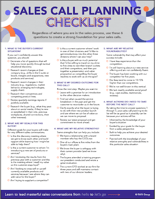I spend a good percentage of my time selling. I also spend a lot of time coaching and training sales teams. One question that comes up time after time is, "How do I shorten the sales cycle?"
My quick response is usually, "Have more in each stage of your pipeline at all times, so the sales cycle just seems shorter."
Of course, that rarely makes anyone feel better. So based on our experience, here are 10 rules that will help make your sales process move more quickly:
10 Rules for Shortening Your Sales Cycle
- Present a Crisp, Clear Value Proposition
- Talk to the Right Person
- Uncover the Prospect's Aspirations and Afflictions
- Engender Trust and Confidence in Your Company
- Deal With Objections Early On
- Plan Each Conversation
- Advance the Sale (and Avoid Continuances)
- Make It Easy for the Prospect to Buy
- Provide Value In Your Marketing
- Be Persistent
1. Present a Crisp, Clear Value Proposition
In the course of my work with all manner of firms, I hear a common lament: "We are becoming a commodity. The prospects just seem to buy on price. How can I separate myself from the crowd?"
If you don't know how you're different, how will the prospect know?
Ask your clients, colleagues, and network, “How do I provide value in what I do?” Once you get the answers, refine the message, practice it, and refine it again. Make certain your statement resonates (speaks to need), differentiates (why you), and substantiates (proof you can do it).
2. Talk to the Right Person
Why do so many of us end up wasting our time (and stretching out the sales cycle) by talking to prospects who have neither the financial ability nor the authority to buy our services? Is it lack of confidence in our abilities to deliver, to sell, or both?
Whatever the reason, the shortest distance to a faster sale is the one to the decision maker. Go into a prospective company at the highest level possible. If you can't start high, find out as quickly as possible who controls the purse strings and who makes the decisions.
3. Uncover the Prospect's Aspirations and Afflictions
How directly are you connecting your products and services with the needs of the buyer and those of her company? Too often, we talk to the prospect rather than with the prospect. Ask questions that will allow you to find the most pressing and compelling needs that your offerings can address. You can then draw a direct line from their needs to your products and services. As the saying goes, "The shortest distance..."
Don’t only look for the pain points (afflictions) that will drive a buyer to solve a problem; also look for their dreams and goals (aspirations) that your services can address so you can drive the demand.
4. Engender Trust and Confidence in Your Company
Unless you have the good fortune to have been introduced through a referral, your buyer has a long list of reasons not to buy. As you are selling, buyers are asking, "Can you do what you say you can?", "Do you really understand my company and what I am facing?", and, "Will I get the return on my investment for your fees?"
Provide stories, case studies, and demonstrable examples of how you have helped similar companies. Don't talk about how good you are. Show it. By doing so, you help reduce the perceived risk of buying. The sooner you can lower the trust barrier, the faster you can move your prospect to make a decision.
5. Deal With Objections Early On
Contrary to popular belief, objections are helpful to the buying process. In fact, I would go so far as to say that objections are buying signals. When a prospect tells you there is an obstacle to buying your services, she is engaging in the buying process. She is telling you, “I'm thinking about what it might be like to work with you, but I have a few things we need to address first.”
The earlier objections come up, the earlier you have the opportunity to fully explore what's getting in the way, deal with it, and move on. The worst possible scenario is for the prospect to nod in agreement and then disappear once you are out of sight (no phone calls, no emails, and no answers) because you never had the opportunity to hear what was standing in the way of the sale.
- Download Now: How to Handle Sales Objections
6. Plan Each Conversation
What do you want to have happen during (and after) the first conversation? The second? The third? The sales cycle gets stalled more often than not because the service provider (or seller) doesn't have a plan. Prepare for each conversation by asking yourself:
- What is my goal for this prospect?
- What is my goal for this conversation?
- What are my strengths going in?
- What are my vulnerabilities?
- Based on the answers, what can you expect and what is your planned next step?
Improv may be fine for comedy, but nothing will derail the sales express faster that trying to figure it out as you go.
7. Advance the Sale (and Avoid Continuances)
An outcome of good planning is your ability to advance the sale to a next step. How often do you or your colleagues call to follow up with a client and say those uninspiring words, "I was just checking to see how things were going"? "Fine," the prospect replies. Pause. "Thanks for calling." Really long pause. End of conversation.
Supply answers to questions, new information, or a reason to have a new discussion about how you can and will meet their needs. How can you help the prospect see the value you will provide? Go into every new conversation with a clear idea of the steps needed to move the buying process along.
8. Make It Easy for the Prospect to Buy
Even after you have refined your value proposition, engendered trust, uncovered needs, planned, etc., the prospect still might have a hard time buying that $300,000 assignment as a first engagement. How can she try out your services to feel comfortable with a larger project?
The best way is to have an entry-level service that shows what you can do in a more manageable fashion. This can take the form of a pilot program, an upfront assessment, or a day of strategy development.
9. Provide Value In Your Marketing
When you sit down at the table with a prospective client for the first time, you might encounter one of two possibilities:
- Possibility #1: "I've never heard of you. I don't know what you offer. I don't know why you're here. What do you want to sell me?"
- Possibility #2: "I've read two of your white papers, saw you speak, and regularly read your newsletter. I love your website and your methodology. I've been looking forward to speaking with you for months now."
Of course, possibility #2 is what you want to hear, but you can only accomplish this through your marketing if you create and leverage value-based offers and experiences. If you do, the sales cycle will have already started before you even have that first exchange.
10. Be Persistent
The average complex sale takes five, six, seven, or more conversations to close. How often do you drop out of the running because you lose interest and quit the cycle halfway through? In the end, quick and steady wins the sale.
By now, you may be wondering if this effort is going to be worth it. Where's the shorter path in this sales cycle? I can assure you the effort is well worth it, but take heed: there really are no shortcuts. Sales success takes a consistent and value-based approach that works over time.
And maybe, just maybe, the quick response was the right (and short) one.







